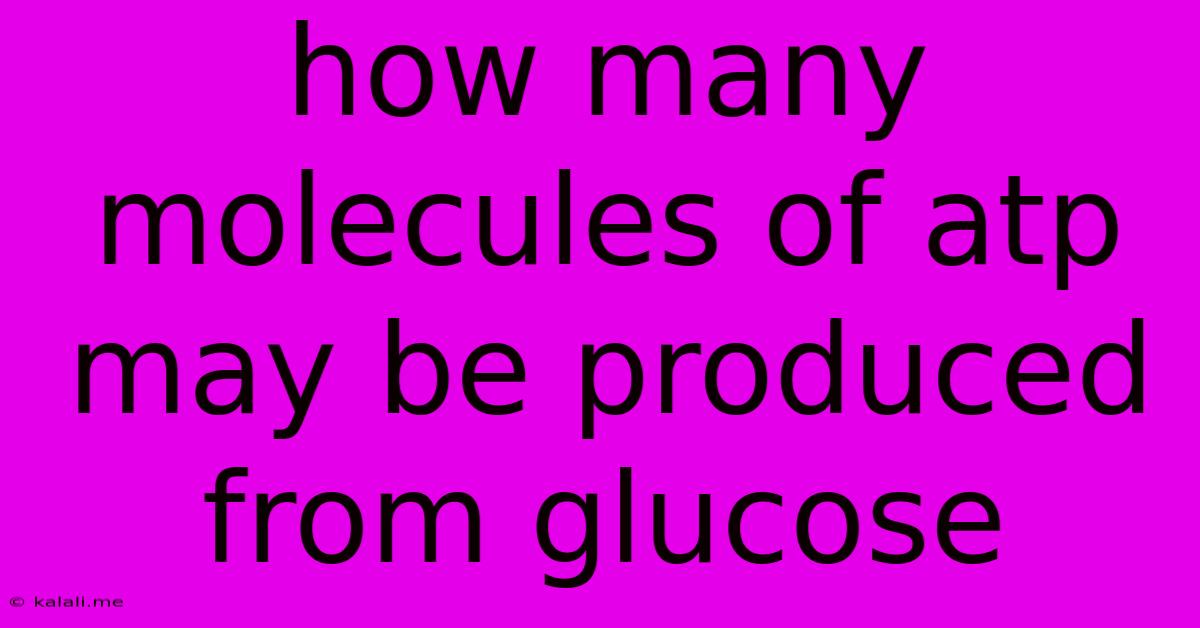How Many Molecules Of Atp May Be Produced From Glucose
Kalali
May 09, 2025 · 3 min read

Table of Contents
How Many ATP Molecules Can Be Produced From One Glucose Molecule? A Deep Dive into Cellular Respiration
The question of how many ATP molecules are produced from a single glucose molecule is a cornerstone of cellular respiration understanding. The short answer is between 30 and 38 ATP molecules, but the specifics depend on several factors we'll explore in detail. This article will delve into the intricacies of glycolysis, the Krebs cycle, and oxidative phosphorylation to provide a comprehensive understanding of ATP yield.
Understanding the Process: A Simplified Overview
Cellular respiration is the process by which cells break down glucose to release energy in the form of ATP (adenosine triphosphate). This multi-step process can be broadly divided into three main stages:
-
Glycolysis: This anaerobic process occurs in the cytoplasm and breaks down one glucose molecule into two pyruvate molecules, producing a net gain of 2 ATP and 2 NADH molecules.
-
Krebs Cycle (Citric Acid Cycle): In the mitochondria, pyruvate is converted into acetyl-CoA, which enters the Krebs cycle. Each glucose molecule (yielding two acetyl-CoA molecules) contributes to the production of 2 ATP, 6 NADH, and 2 FADH2 molecules.
-
Oxidative Phosphorylation (Electron Transport Chain & Chemiosmosis): This is where the majority of ATP is generated. NADH and FADH2 donate electrons to the electron transport chain, a series of protein complexes embedded in the inner mitochondrial membrane. This electron flow generates a proton gradient across the membrane, driving ATP synthesis through chemiosmosis. The exact ATP yield from this stage varies depending on the shuttle system used to transport NADH from the cytoplasm to the mitochondria.
The Variable ATP Yield: Why the Range?
The variability in ATP yield (30-38 ATP) stems primarily from the different mechanisms for transporting NADH produced during glycolysis into the mitochondria.
-
Glycerol-3-phosphate shuttle: This shuttle system is less efficient, resulting in a net gain of 1.5 ATP per NADH molecule.
-
Malate-aspartate shuttle: This system is more efficient, yielding 2.5 ATP per NADH molecule.
Therefore, the total ATP yield depends on which shuttle system is predominantly used by the cell.
Detailed ATP Breakdown:
Let's break down the ATP production per stage, considering both shuttle systems:
-
Glycolysis: 2 ATP + 2 NADH (5 ATP via malate-aspartate shuttle or 3 ATP via glycerol-3-phosphate shuttle)
-
Krebs Cycle: 2 ATP + 6 NADH (15 ATP via malate-aspartate shuttle or 9 ATP via glycerol-3-phosphate shuttle) + 2 FADH2 (3 ATP)
Total ATP Yield:
-
Malate-aspartate shuttle: 2 + 5 + 2 + 15 + 3 = 37 ATP
-
Glycerol-3-phosphate shuttle: 2 + 3 + 2 + 9 + 3 = 19 ATP
Important Considerations:
-
The theoretical maximum of 38 ATP is rarely achieved in reality. Energy is lost during various stages of the process.
-
The actual ATP yield can be influenced by factors such as cellular conditions, temperature, and the availability of substrates.
Conclusion:
While the simplified answer is often given as 36 or 38 ATP, the reality is more nuanced. The efficiency of NADH transport significantly affects the final ATP count. Understanding the intricacies of each stage of cellular respiration allows for a more complete comprehension of this crucial energy-generating process. The range of 30-38 ATP provides a realistic estimate, reflecting the variability inherent in biological systems. This detailed breakdown helps clarify the process and the reasons behind the fluctuating ATP yield.
Latest Posts
Latest Posts
-
Determine The Mass Of The Sun
May 09, 2025
-
How Much Is 5 Oz In Grams
May 09, 2025
-
Median In A Stem And Leaf Plot
May 09, 2025
-
What Percent Of 80 Is 100
May 09, 2025
-
How Much Is 24 Inches In Centimeters
May 09, 2025
Related Post
Thank you for visiting our website which covers about How Many Molecules Of Atp May Be Produced From Glucose . We hope the information provided has been useful to you. Feel free to contact us if you have any questions or need further assistance. See you next time and don't miss to bookmark.